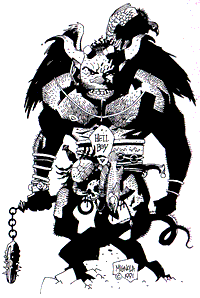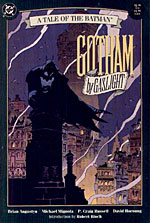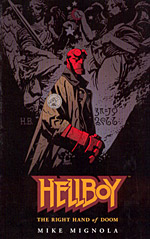>> Comment: A Shot Of MoCCA
>> Comment: He Could Be Wrong, He Could Be Wright
More...

Mike Mignola was born in 1962. Raised on a steady diet of monster movies, horror novels and Jack Kirby, he made his first foray into comic books at nineteen years of age with the publication of a fanzine called The Comic Reader. Shortly thereafter, Mignola accepted his first job as a professional comic artist when he was employed as an inker for Marvel Comics.
After becoming an established artist-for-hire at Marvel and DC Comics, Mignola became intrigued with the growing independent scene. While many genuinely talented artists were launching creator-owned series about thinly-veiled rip-offs of mainstream comic book characters, Mignola made the wise decision of signing on to the Legend Imprint at Dark Horse Comics, where established greats like Frank Miller and John Byrne were letting their imaginations go wild to such startling results as Miller's black-and-white masterpiece SIN CITY and Byrne's super-hero fable THE NEXT MEN.
 His most famous character, Hellboy, first appeared on the cover of a convention program book as a hirsute and drooling demon, glowering menace at the reader. On his belt was the name Hellboy. Aware that he'd created something much more interesting than a one-off joke character, Mignola began to explore the possibilities of launching this demonic thing's own comic book.
His most famous character, Hellboy, first appeared on the cover of a convention program book as a hirsute and drooling demon, glowering menace at the reader. On his belt was the name Hellboy. Aware that he'd created something much more interesting than a one-off joke character, Mignola began to explore the possibilities of launching this demonic thing's own comic book.
He enlisted John Byrne to write the first HELLBOY mini-series in order to learn comic-book plotting, as he didn't yet feel confident enough to take on the writing chores himself. HELLBOY has continued for over ten years as a series of story arcs and trade collections. The series has grown from horror and adventure stories into a study of mythology and its relationship to pulp novels and comic books.
LANDMARKS
1982 - Mike Mignola received his first few assignments from Marvel Comics and did interior and cover work for books such as ALPHA FLIGHT, DAREDEVIL, POWER MAN & IRON FIST, MASTER OF KUNG FU and KA-ZAR THE SAVAGE.
1985 - Mignola turned his attention and fledgeling talent to an adventure-seeking and space-travelling anthropomorphic animal law officer named Rocket Raccoon. Representing Mignola's first regular series work, ROCKET RACCOON lasted only four issues but is fondly remembered alongside such notable mid-eighties Marvel stalwarts as Heathcliff, Count Duckula and The Muppet Babies.
In addition to ROCKET RACCOON, Mignola became a regular cover artist for THE INCREDIBLE HULK and THE NEW DEFENDERS. His style began to adapt away from Marvel's house style into an interpretation of Jack Kirby's signature body types and swirls of cosmic radiation.
 1988 - After becoming a regular fixture at Marvel Comics, Mignola accepted a few offers at DC Comics such as a PHANTOM STRANGER mini-series THE WORLD OF KRYPTON. His style had become instantly recognisable on the comics scene. Mignola came over to DC at an opportune time, as works such as THE WATCHMEN and THE DARK KNIGHT RETURNS had opened the doors for mature readers books at DC. Mignola's gloomy and expressionist figures provided stunning visual dimensions to COSMIC ODYSSEY, written by Jim Starlin, which took some of the biggest names in DC Comics on a romp through Jack Kirby's Fourth World.
1988 - After becoming a regular fixture at Marvel Comics, Mignola accepted a few offers at DC Comics such as a PHANTOM STRANGER mini-series THE WORLD OF KRYPTON. His style had become instantly recognisable on the comics scene. Mignola came over to DC at an opportune time, as works such as THE WATCHMEN and THE DARK KNIGHT RETURNS had opened the doors for mature readers books at DC. Mignola's gloomy and expressionist figures provided stunning visual dimensions to COSMIC ODYSSEY, written by Jim Starlin, which took some of the biggest names in DC Comics on a romp through Jack Kirby's Fourth World.
During this year, Mike Mignola also provided the covers for the controversial "Death of Robin" series BATMAN: A DEATH IN THE FAMILY, and helped plant the idea for Elseworlds with his work on GOTHAM BY GASLIGHT - a Batman-themed re-imagining of the Jack the Ripper murders, written by Brian Augustyn.
1989 - Having established himself as a talent to watch, Mignola then spent a quiet year doing a few back-up stories for THOR, rounding out the year drawing a SWAMP THING annual, written by Neil Gaiman.
1993 - A small independent publisher named Dark Horse Comics hit the scene by making deals with motion picture companies, adapting such blockbusters as ALIENS and TERMINATOR into comic form. Some work drawing a few storyboards for BRAM STOKER'S DRACULA allowed Mignola to work directly with the director Francis Ford Coppola, and sparked the beginning of Mignola's Hollywood courtship. He subsequently provided the art for the comic book adaptation of DRACULA.
1994 - HELLBOY: SEEDS OF DESTRUCTION was released by Dark Horse Comics. Mignola asked John Byrne to write the first Hellboy outing as Mignola had never written a comic before. Hellboy's appearance was based on Mignola's love of monsters and his persona was based on his father, who, as Mignola said in an interview for Comic Book Resources; "Had all these jobs building cabinets and [used to come] home busted up, with [dried] blood all over him and he was so matter of fact, saying, 'oh yeah, I got my hand stuck in this machine and all chewed off'. That's a lot of what Hellboy is and I just wanted to draw monsters." The trade collection was dedicated in part to Jack Kirby and HP Lovecraft. Hellboy had transformed from a one-off joke into Mignola's guiding passion.
1996 - While first intending to only use Hellboy as a bizarre-looking curiosity, Mignola began to wonder if Hellboy's origin story would garner discussion. He explained the reason for Hellboy having a giant stone hand by saying that Hellboy is Anung Un Rama, the Son Of The Beast and Bringer Of The Apocalypse, lost forever to the world of mortals after eating a pancake. With the release of THE RIGHT HAND OF DOOM and a series of scattered back-up stories and one-shots, Mignola set the tone for his character study of Hellboy by crafting him as the protagonist of various Eastern European folk tales. The result is part spooky ghost story and part cosmic romp.
 The Legends imprint had since given way to Maverick. In The Comics Journal #189, Mignola explained the time just before helping to launch the Legends imprint at Dark Horse Comics was one of exciting possibilities in the comics industry, where artists and writers were financing their own stories and still making a living. He explained his new-found artistic freedom as a challenge: "With the HELLBOY stuff, working completely from just a blank piece of paper- no script, no nothing - I allowed myself to wander a lot more and treat it in some places almost like a truly visual thing... Does this have to be a page, or can this be three pages?"
The Legends imprint had since given way to Maverick. In The Comics Journal #189, Mignola explained the time just before helping to launch the Legends imprint at Dark Horse Comics was one of exciting possibilities in the comics industry, where artists and writers were financing their own stories and still making a living. He explained his new-found artistic freedom as a challenge: "With the HELLBOY stuff, working completely from just a blank piece of paper- no script, no nothing - I allowed myself to wander a lot more and treat it in some places almost like a truly visual thing... Does this have to be a page, or can this be three pages?"
2001 - Walt Disney Pictures released ATLANTIS: THE LOST EMPIRE. Mignola provided character designs and storyboards - in other words, he got to draw some fish.
2002 - Following the publication of a string of HELLBOY novelisations by Christopher Golden, Mignola became involved in the preliminary development of the Guillermo del Toro-directed HELLBOY movie. Meanwhile, in the comics series, Hellboy broke away from The Bureau for Paranormal Research and Defense to go in search of his origins, while various supporting characters like Abe Sapien, Roger the Homunculus and Johann Kraus filled in the absence of new HELLBOY material in a new series called BPRD. Christopher Golden and Ryan Sook worked closely with Mignola to launch it.
Mignola also made his first foray outside of HELLBOY for several years with the one-shot THE AMAZING SCREW-ON HEAD, a tale about a disembodied mechanical head ordered by Abraham Lincoln to stop a rotting corpse from destroying the world. While the one-shot met with glowing reviews, Mignola deferred continuing on with the character, afraid that he'd ruin Screw-On Head's appeal by trying to duplicate it.
2003 - While still busy on the HELLBOY motion picture, Mignola started an anthology series titled HELLBOY: WEIRD TALES and brought in some of comics' finest creators to give their interpretations of Hellboy and his world. John Cassaday created an on-going Lobster Johnson series for it, pastiching 1940s comic book art.
RECENT DAYS
Mignola keeps a relatively low-profile, with promises of a new HELLBOY comic as soon as his schedule allows. If there's one thing Mignola has proven over the course of his career, it's that the more time he has to work on something, the better it turns out, and he's promised to continue telling stories about Hellboy once the movie fervour has died down. The HELLBOY movie is scheduled for an April 2nd release in the US.
NINTH ART RECOMMENDS
FURTHER READING: While COSMIC ODYSSEY represents Mignola at the height of his DC career, it's not until THE RIGHT HAND OF DOOM, the second HELLBOY trade, that he truly comes into his own. For a taste of why HELLBOY appeals to so many readers, check out THE RIGHT HAND OF DOOM, although it's not until THE CHAINED COFFIN AND OTHERS that HELLBOY begins to develop a genuinely organic comics mythology. The 200 page ART OF HELLBOY is also available from Dark Horse in both paperback and hardback editions.
MIGNOLA ON HELLBOY
"I love listening to Shakespeare, love the rhythm, I'll have bad guys yakking on and on, sometimes based on something Shakespearean, but then I catch myself and get kinda embarrassed with what I'm doing and Hellboy's voice steps in, punching a whole in the kinda pompous balloon, y'know, Hellboy interrupting the bad guys and saying, 'Big talk for a guy with no pants' or whatever he's saying. It kinda lets the audience know I'm not taking it too seriously - obviously I'm serious about the work, but I like having a guy who lightens things up a bit." - Comic Book Resources, January 30 2004.

This article is Ideological Freeware. The author grants permission for its reproduction and redistribution by private individuals on condition that the author and source of the article are clearly shown, no charge is made, and the whole article is reproduced intact, including this notice.


